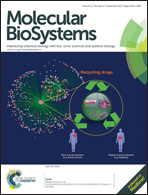Phenotypic side effects prediction by optimizing correlation with chemical and target profiles of drugs†
Abstract
Despite technological progresses and improved understanding of biological systems, discovery of novel drugs is an inefficient, arduous and expensive process. Research and development cost of drugs is unreasonably high, largely attributed to the high attrition rate of candidate drugs due to adverse drug reactions. Computational methods for accurate prediction of drug side effects, rooted in empirical data of drugs, have the potential to enhance the efficacy of the drug discovery process. Identification of features critical for specifying side effects would facilitate efficient computational procedures for their prediction. We devised a generalized ordinary canonical correlation model for prediction of drug side effects based on their chemical properties as well as their target profiles. While the former is based on 2D and 3D chemical features, the latter enumerates a systems-level property of drugs. We find that the model incorporating chemical features outperforms that incorporating target profiles. Furthermore we identified the 2D and 3D chemical properties that yield best results, thereby implying their relevance in specifying adverse drug reactions.


 Please wait while we load your content...
Please wait while we load your content...